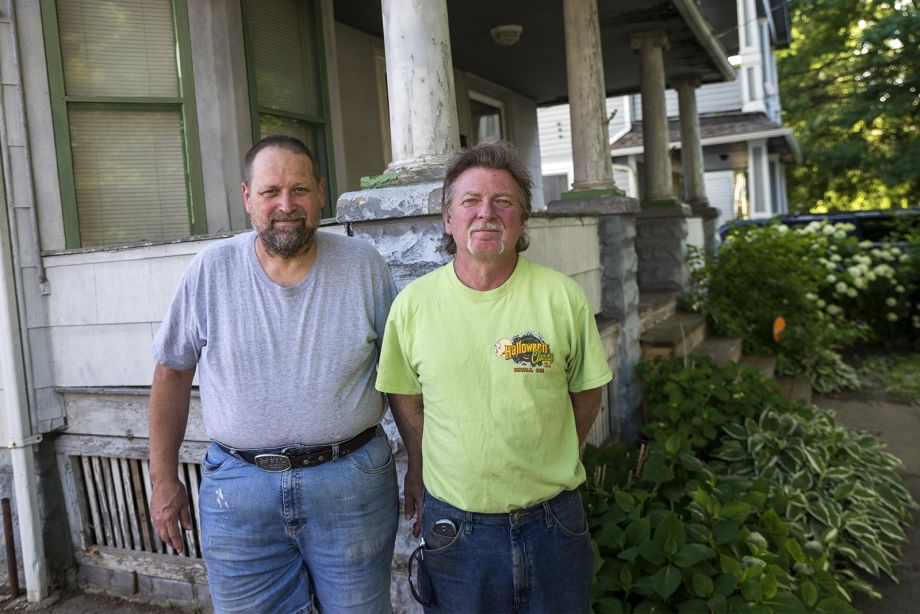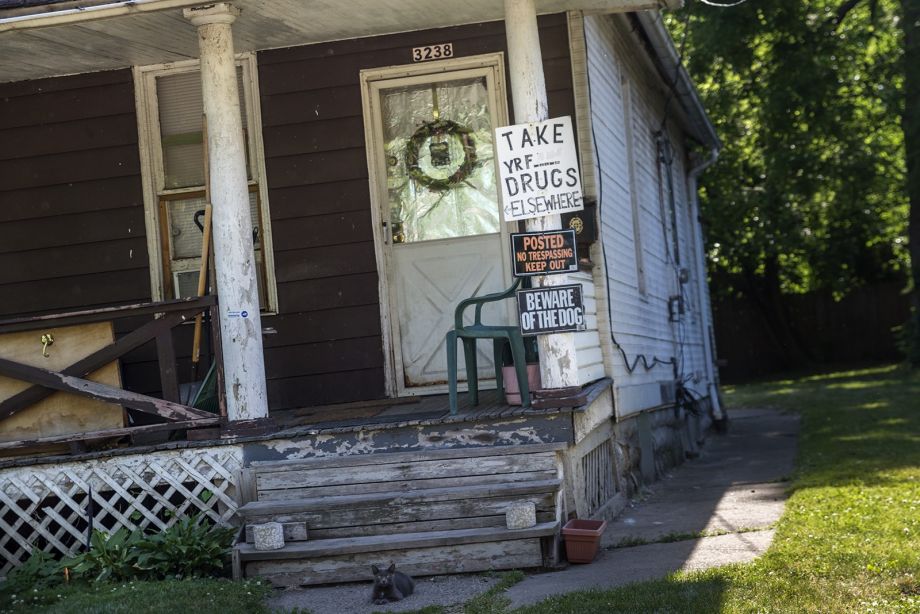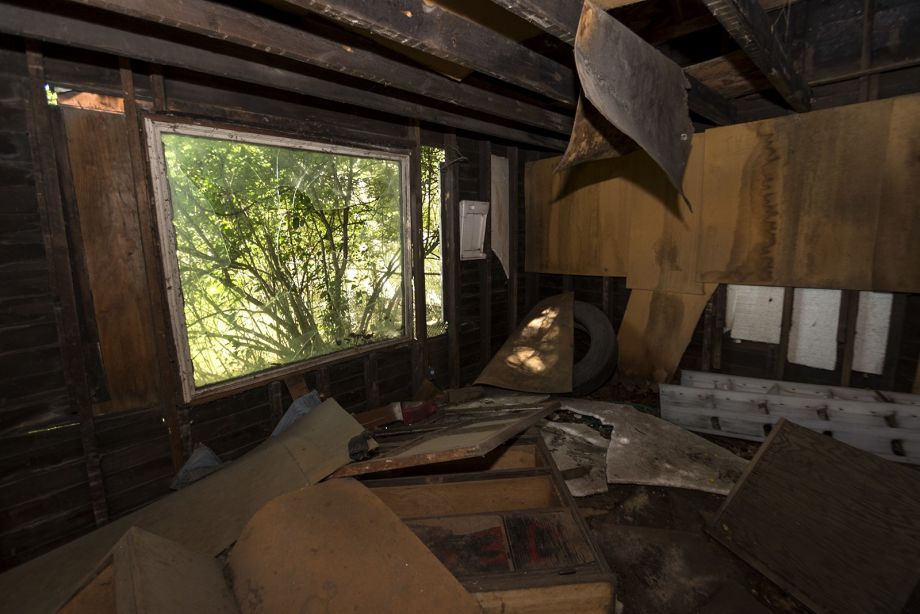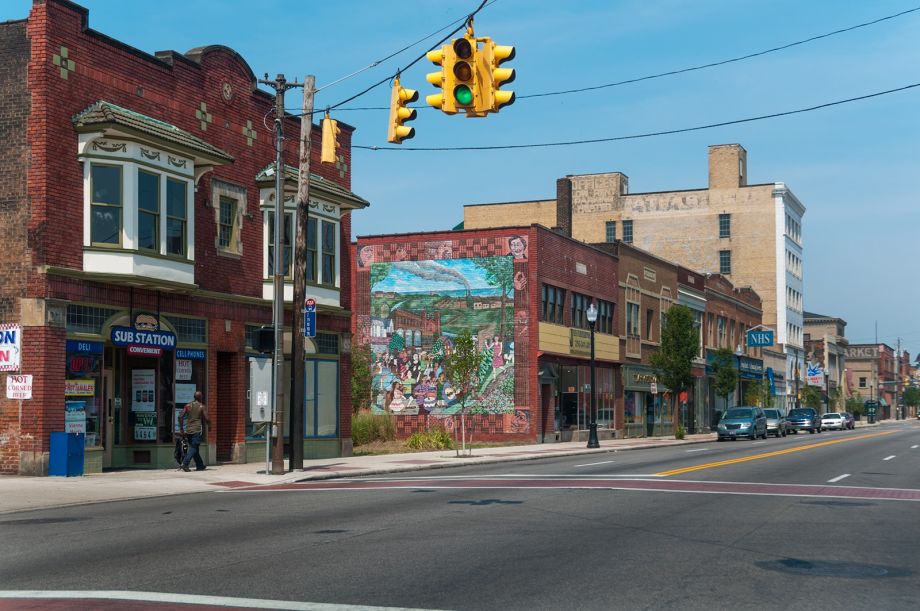Are You A Vanguard? Applications Now Open
This is your first of three free stories this month. Become a free or sustaining member to read unlimited articles, webinars and ebooks.
Become A MemberAnthony Brancatelli is angry. The Cleveland city councilman is driving through the Slavic Village section of his district and counting the empty lots. “Ten years ago,” he says, “there would be a house on every one of these lots and a good percentage would be owner-occupied. That’s how quick things went downhill.”
The councilman is taking me on a tour of a part of Cleveland that first came onto the world’s radar in 2007 when it became the canary in the mortgage crisis’s coal mine thanks to the toxic convergence of a shrinking local economy with an unregulated mortgage industry and thousands of profit-hungry house-flippers. We are here to survey how the neighborhood that once boasted the highest foreclosure rate in the nation is doing one month before the Republican National Convention convenes just a few miles away to nominate a candidate for president. That nominee will likely be Donald Trump, a real estate mogul who once sold subprime mortgages though a short-lived venture called Trump Mortgages and taught America, through a for-profit education company he founded called Trump University, how to profit from foreclosures.
In the same year that Slavic Village lost 783 homes to foreclosure, Trump University was running ads with a picture of its founding namesake and the message, “Investors Nationwide are Making Millions in Foreclosures … And So Can You!”
In a 2009 investigation of Trump University, the Texas Attorney General’s Office found “the training material we reviewed indicate that [the] Trump University three-day seminar attendees are taught to prey upon homeowners in financial turmoil and to target foreclosure properties.” The office dropped its investigation of fraud when Trump agreed not to do any more Trump University seminars in Texas.
“It is the irony of all ironies,” Brancatelli says. “One of the biggest issues in Cleveland is how the property values in many neighborhoods haven’t recovered from the subprime foreclosure problems, and how many of these problems came from outside investors who didn’t even pretend to fix up houses or put lipstick on the pig. They used shell corporations and fake names so we couldn’t find them for housing code violations. And one of the guys who encouraged this way of doing business, and who profited from it, is being nominated for president just a few miles away.”
The story of Slavic Village should be familiar to anyone who has spent time learning about the history of American cities. The neighborhood grew on the edge of the Cuyahoga River, near the steel mills that powered Cleveland’s development as an industrial powerhouse in the early 20th century. Its streets of simple, modest homes rose quick and dense, as tens of thousands of immigrants settled close to factory jobs and began to erect churches, schools and small businesses. This is the neighborhood that Brancatelli, who is 59, grew up in, the grandson of Polish and Italian immigrants and son of an auto mechanic and a waitress turned store clerk.
But by the time Brancatelli graduated from Cleveland State University in 1982, his neighborhood had fallen into hard times. The steel mills had closed and the neighborhood’s population was vastly reduced from its 1940 peak of 69,000. By 2007 when the mortgage crisis reared its ugly head, 1 in 11 houses were boarded up and the population was down to 30,000. In the nine years since, the neighborhood has lost another 8,000 people.
Walter Eddy, a school janitor, remembers coming home one day about five years ago and smelling natural gas fumes out in his yard. The stench was coming from a house a few doors down that had been abandoned after a foreclosure. The gas had never been turned off, and when the scrappers had moved in to take the copper pipes and aluminum siding and anything of value, they had cut and taken the gas pipes too.
“We went inside and were able to find the valve to turn the gas off, but who knows how long that gas had been shooting out,” Eddy says. “The whole neighborhood could have blown up.”
Eddy says that the incident demonstrated to him the damage wrought by the housing crisis.
“First, these thieves stealing metal pipes were pretty much doing it in broad daylight. And then, because most of houses on the street were now filled with renters who had no longtime affiliation with this neighborhood, well, they didn’t even notice the gas smell,” he says. “What’s been lost in this housing crisis here is that neighbors aren’t keeping an eye out for each other like they used to.”

Neighbors Walter Eddy (left) and Jerry Bieda came home after work five years ago to discover that scrap metal thieves had cut the gas pipes out of a house on their street while the gas was still on.
In a study published this year by the Economic Innovation Group, a D.C.-based think tank, Cleveland was found to be the most economically distressed major city in America based on the most recent economic census data broken down by ZIP codes. One of the ZIP codes in Slavic Village (44127) was identified as the ninth most distressed urban ZIP code in the nation.
It didn’t have to end up like this, according to Kathleen Engel, a research professor of law at Suffolk University in Boston and co-author of The Subprime Virus: Reckless Credit, Regulatory Failure and Next Steps. In their book, Engel and co-author Patricia A. McCoy describe how in the late 1990s and early 2000s “it looked like Cleveland might be shedding its reputation as a postindustrial wasteland after all.” But before that could happen the subprime crisis unfolded and the investors swept in. While Engel and McCoy outline the multiple factors that played into the collapse of Cleveland’s housing market, from bank deregulation to population trends, they lay much of the blame for the crisis at the feet of investors buying up deeds in search of an easy buck.
“Homeownership by investors is really bad for neighborhoods, and that’s what we saw — and still see — in Cleveland,” says Engel, who was teaching at the Cleveland-Marshall College of Law just a few miles from Slavic Village when the bottom dropped out.
She says Slavic Village might have been able to deal with its shrinking population and the troubled housing market if it had just been dealing with a subprime crisis caused by banks lending to local people who maybe shouldn’t have qualified in the first place.
“But what was being pushed by these groups like Trump University was that buying a house for $5,000, no matter where it was or what condition it was in, was going to make you lots of money,” Engel says. “The people buying these properties this way usually lost out on these deals in the end, and neighborhood like Slavic Village lost out as well.”
Blaine Murphy was one of these investors. Murphy, who lived at the time in a million-dollar house in Naples, Florida, bought his first Cleveland property in 2005. Over the next five years, he would buy and sell a total of 235 houses in the city, including 20 in Slavic Village. (Some of the purchases were made with fake names.) Murphy owned a yacht and drove a Porsche, yet nearly half of his Cleveland houses fell into foreclosure. By 2013, he owed more than $1 million in back taxes.
With help from the FBI, a county prosecutor tracked Murphy down, and he was convicted in 2013 of real estate fraud. He was sentenced to two years in prison, ordered to pay $1 million in restitution, $100,000 in fines and to help on demolitions as part of community service.
But the Murphy case was a rarity. Because of the complexity of property transactions, local law enforcement and city code inspectors often had trouble finding who owned the property when housing code violations and tax delinquency had to be dealt with. There was a constant churn, and infomercials and hotel seminars like Trump University’s that taught would-be flippers how to use holding companies and anonymous identities to game the market in their favor. Basically, how not to get caught.

A high number of vacant homes caused by the foreclosure crisis has made drug use a major problem in Slavic Village.
Howard Katz is a law professor at Duquesne University School of Law in Pittsburgh, but between 1998 and 2004 he worked at the county treasurer’s office in Cleveland. He too remembers the years before the foreclosure crisis as a period of hope for Slavic Village. “The overall economy wasn’t great, but Slavic Village was still hanging on in some respects, because the ones buying the subprime foreclosure mortgages were mostly local and they wanted to keep people in the homes for rental income,” says Katz.
“What happened was these new players did not care if someone was living in the home or not, all they cared about was trading contracts back and forth,” Katz says. “And that’s when everything went off the cliff, and in Cleveland, they are still dealing with the aftermath.”
A recent survey of Cleveland housing prices by the Western Reserve Land Conservancy, a nonprofit land trust and revitalization organization, bears that out. The peak year for sales in Cleveland was 2005, when the average “arm’s length” sale (excludes sheriff’s foreclosure sales, or ones that involve a bank or government agency as the seller or buyer) in Cleveland was $84,588. By 2008, the average arm’s length sale had fallen to $9,900. Last year, the average sales price stood at $28,000, a mere 33 percent of the 2005 values.
The numbers tell an even more extreme story in Slavic Village. There, the 2005 sales peak was $75,000. By 2008, the average sales price had plummeted to $5,000. While values are inching up, the average sales price was only $14,875 last year. Meanwhile, home values on a national level are now 13 percent higher than they were in 2005.
Frank Ford, a senior policy adviser for the conservancy and the author of the study, went to hotels for seminars promoting foreclosure-related get-rich-quick schemes and tried to warn away attendees. He says he passed out flyers warning that housing code violations and tax liens and other pertinent information didn’t show up on the deeds people were being encouraged to buy and trade. He remembers telling attendees that the small print on these houses might impede any fast money dreams.
“The major problem [is] that many of these people were being told to buy up as much as they could, and they weren’t being told all the details [by the instructors],” Ford says. “So when they found out about all the problems they might have had on these properties, many thought the best way to deal with it is just walk away. And the government agencies in Cleveland and the community groups who lived in those neighborhoods had to clean up the mess. And as we can see from the numbers, the foreclosure crisis is not over in many Cleveland neighborhoods.

Cleveland City Councilman Anthony Brancatelli has been aggressively working to get abandoned homes torn down In Slavic Village, but funding issues have created a long waiting list.
Given all this, it comes as little surprise that the city of Cleveland has been on the front lines of fighting subprime lenders. In 2008, the solidly Democratic city sued 21 banks and mortgage companies for their damaging lending practices. The case was eventually dismissed but not before the city’s mayor described the industry as “organized crime.”
“It has the same effect as drug activity in neighborhoods,” Mayor Frank Jackson, a Democrat, said in an interview with The Plain Dealer when the suit was filed. “It’s a form of organized crime that happens to be legal in many respects.” (Jackson declined to comment for this story.)
Just before Cleveland filed its lawsuit, Brancatelli, along with other local political and business leaders went on their own trip to the nation’s capital. They went to testify at a hearing before Congress’ Joint Economic Committee.
“These properties were purchased as foreclosures,” Brancatelli testified. “They were sold to investors and now being foreclosed on again. It is a cycle that is not ending. If you look at the people buying these homes, they’re buying 10 to 15 homes at a time … it’s absolutely horrifying to see what is happening in our community.”
Brancatelli called for criminal punishment for those who lie on documents relating to mortgages and other real estate transactions, something that Trump University instructors are accused of advising their students to do, according to the federal lawsuit against Trump now being heard in California. Indeed, one Trump University instructor, Steve Goff, shared the strategy he was teaching his students with the Los Angeles Times in 2007 and the sensibility is not far off from that of Murphy who was eventually indicted for real estate fraud. “You do not have to own real estate to make money from it,” Goff said. “You just have to control it. You can control it with contracts.”
An ad that ran around the same time summed up Trump’s view of the foreclosure crisis this way: “The current rise in foreclosures is an incredible opportunity for you to make legendary real estate deals. It’s time to achieve the privileged life you’ve always dreamed about.” Trump declined to comment for this story.
Before the foreclosure market was even a glint in Trump’s eye, Jim Rokakis was working in Cleveland to help the city recover from the one-two punch of deindustrialization and population loss that paved the way for the mortgage crisis. Through 19 years as a Cleveland councilman, 14 years as the county treasurer and now as vice president of the Western Reserve Land Conservancy, Rokakis has worked with others across the public and private sector to revitalize neighborhoods, clearing blight, conserving green space and attracting investment. The notion that Trump could very well be nominated to the highest office in the country in Cleveland is “the most ironic thing I’ve ever experienced in my lifetime in politics and public service,” he says. Rokakis, a Democrat, regards Trump and other players in the foreclosure market as “the vultures who caused so much hardship in Cleveland, who didn’t care that they profited from other people’s misery.”
Vultures they may be in Rokakis’ worldview but to Trump, they are players worth taking on the road to the White House. In May, Trump named Steven Mnuchin as his campaign finance chairman. Mnuchin is the chairman and CEO of Dune Capital Management LP, a private investment firm. At Dune, the former hedge fund manager and his investors bought out IndyMac, a failed subprime loan bank that collapsed in 2008. In 2011, foreclosed homeowners demonstrated on the lawn on Mnuchin’s Bel Air mansion in protest of the bank’s handling of their mortgage assets. Though the federal government was left holding the bag on the bad loans as part of the sales deal, Mnuchin made a tidy profit from selling the bank last year. According to news reports, he and his investors turned their $1.55 billion investment into a $3.4 billion payday.

The population of Slavic Village peaked in 1950 with 70,000 people, and 22,000 live there now.
Trump has shared few substantive details of how he would lead the country. There is, however, little doubt that his stated plans to deport millions of undocumented immigrants, engage in trade wars and lower taxes could have dire consequences on Cleveland and other cities that rely heavily on the economic impact of immigrants, globalized trade and social safety net programs funded by tax revenue. A plunge back into recession would be the ultimate result of the presumptive nominee’s proposed plans, according to a recent report from Moody’s Analytics.
“Broadly, Mr. Trump’s economic proposals will result in a more isolated economy. Cross-border trade and immigration will be significantly diminished, with less trade and immigration, foreign direct investment will also be reduced,” Moody’s analysts wrote.
Trump has also suggested that deregulation of the mortgage and real estate industry would be on his agenda. To be sure, that is not an idea that Rokakis and others champion.
“Cleveland worked so hard to get this convention, to show the effort that this city has done to come back from this mess caused in many ways by the subprime lending crisis,” says Rokakis. Now that “the person being nominated is one of the people who worked to profit from that — and who helped make things worse in Cleveland than they should have been — well, that’s just hard for many of us to swallow.”
In the primary election held in March, Hillary Clinton won the most Cleveland votes of any candidate. Among Republicans, John Kasich, who is the governor of Ohio, won by a wide margin, but Trump was second with nearly 46,000 votes in Cuyahoga County. Zooming out to a state level analysis, Trump is now doing better, with Clinton only leading the presumptive Republican nominee by a small margin. Voters in the perennial swing state have said they think Trump would be more effective in creating jobs, though they believe Clinton is more intelligent and has higher moral standards.
Rokakis described Slavic Village as being “in danger of becoming a ghost town” in an op-ed he wrote for The Washington Post in 2007.
Nine years later, the neighborhood has regained some of the vibrancy that many feared would be lost forever.
In June, about 600 people turned out for the neighborhood’s annual Pierogi Dash, a 5K run that ends with participants feasting on traditional potato pierogies and smokies, a local delicacy best likened to homemade Slim Jims, all washed down with beer.
Out on the course, Anthony Trzaska, 32, and a few friends passed out orange wedges and serenaded runners with polka music. (“In heaven there is no beer/That’s why we drink it here/And when we’re all gone from here/Our friends will be drinking all the beer”). Trzaska is a lawyer from a family that has operated a funeral home in Slavic Village since 1958. These days, he is trying to revive properties in the neighborhood, work that he likens to his family’s mortuary business. Buying real estate in Slavic Village “is like chasing one dead entity that owns other dead entities,” he says. “It often takes six months to find out who owns the property, and then you find it’s been sold to someone else just days before and the chase begins again. Everything has something attached to it.”
But still he moves on, with a catchphrase of “The New Wave of the Old World.” On the neighborhood’s commercial corridor he is renovating storefronts with apartments on the floors above and trying to remake an old Slovenian ethnic hall into a modern bowling and music venue. He is working to bring in millennial sausage makers and a farmers market. Small steps, he says, with the big ones coming in time.

Broadway Avenue, one of the Slavic Village's main streets, runs diagonally through the district.
“In some ways, operating in a market where the bones have been picked clean by the vultures creates opportunities for people like me,” he says. “The foreclosures have steadied now, and maybe that’s because there aren’t any more properties to foreclose upon.”
And as for Trump being nominated just a few miles away? “[Trump] is correct when he advocated that it is perfectly legal to make deals and control properties with certain types of contracts,” he says. “But what about everything else? Like the moral fiber and scruples to do what is right? And maybe to just think about how this mortgage flipping and trading affected real people in very real neighborhoods.”
“Whether that is the mindset you want for your president, I’ll leave that for other people to debate,” Trzaska says. “But it is very absurd and somewhat scary to realize a businessman like him — who actively took part in the foreclosure crisis on the profit-making side — is going to be nominated for president by a major party right near ground zero of the subprime mortgage fraud problems. But absurd things happen in Cleveland. They always have.”
Our features are made possible with generous support from The Ford Foundation.
Bob Perkoski is a firmly established Cleveland freelance photographer who captures events in real time. The resulting journalistic photos reveal the stories all on their own with visual flair. Since 2010, Perkoski has documented the area's unprecedented renaissance with a unique and personal perspective for more than 100 clients including Fresh Water Cleveland, Belt Magazine, The Guardian and Sun News.

20th Anniversary Solutions of the Year magazine